Understanding Clock Hands: Their Role and Significance
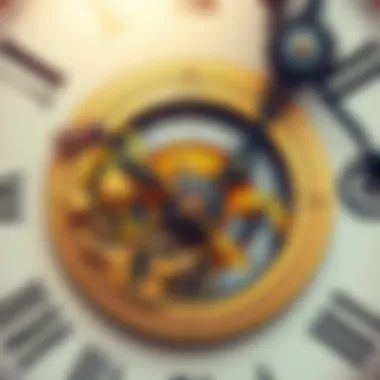
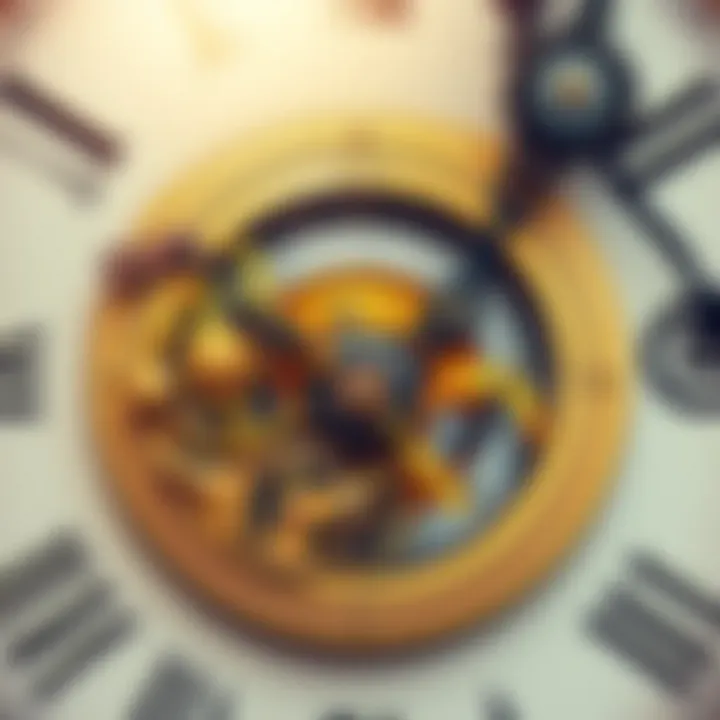
Intro
Timekeeping is as old as civilization itself. From sundials to atomic clocks, the essence of tracking time has changed significantly, yet some fundamental elements remain constant. Among these crucial components are clock hands, which serve a dual identity: they are both functional tools for telling time and artistic elements that add beauty to clock designs. This article will shed light on the fascinating world of clock hands, exploring their various styles, purposes, and the roles they play not just in how we perceive time, but also in the aesthetics of horology.
The Essence of Clock Hands
Clock hands are not just for show. Each one, whether it be the hour, minute, or second hand, fulfills a specific role in the intricate dance of timekeeping. Understanding their functions gives us insight into how time is measured and perceived across different cultures. In many ways, they act like a choreographed performance, displaying not just numbers but the rhythm of time itself.
Clock hands turn, not just in circles, but in a language of their own, telling us when to rise, when to rest, and in between, the countless moments that make up our lives.
Through this article, we will delve into the historical context surrounding clock hands, examining how they have evolved from simple markers to intricate designs that reflect the artistic inclinations of the time. Additionally, we will look at the mechanics that enable these hands to move accurately, dissecting the gears and springs that function behind the scenes. Join us as we unravel the layers of significance that clock hands hold in both timekeeping and aesthetics.
Prelude to Clock Hands
Clock hands might seem simple at first glance, but they hold a world of significance in our understanding of time. Their design, movement, and mechanics are interwoven into the very fabric of horology—the study of timekeeping. For many, clocks are not just tools for scheduling; they represent an age-old quest to measure moments.
In this article, we will explore how clock hands serve as both functional components and artistic elements. Each type of hand reveals much about the craft of clock-making and cultural interpretations of time. For instance, an ornate hour hand can reflect the craftsmanship of its maker, while a minimalist second hand might suggest modernity and efficiency.
The Basics of Time Measurement
Time measurement is a universal endeavor, deeply embedded in historical and cultural practices. Since ancient civilizations, humans have sought to divide the day into manageable segments. The development of clock hands is pivotal in this journey. Think of the sundial used by Egyptians or the water clocks of ancient China; both are early attempts to translate the sun’s movement into proper time.
Key Points about Time Measurement:
- Historical Context: Ancient devices laid the groundwork for modern timekeeping.
- Fraction of Time: The division of the day into hours, minutes, and seconds is essential for coordination in society.
- Cultural Perspectives: Different cultures have their unique approaches to time, influencing how clock hands are designed and interpreted.
- Reliability of Measurement: Accurate timekeeping allows civilizations to thrive, impacting everything from agriculture to commerce.
Understanding these basics sets the stage for appreciating the intricacies of clock hands. They are not mere pointers; they are symbols of human ingenuity in measuring the fluidity of time.
Understanding Clock Mechanics
To truly grasp the importance of clock hands, one must delve into the mechanics that drive them. Each hand is connected to a complex system of gears and springs that function harmoniously to keep time. At the heart of this system are two main types of movement mechanisms: mechanical and quartz.
In mechanical clocks, hands are powered by winding a spring. As the spring unwinds, gears move, powering the hour and minute hands in a steady rhythm. Quartz clocks, on the other hand, utilize electrical oscillations to maintain precise time, making them incredibly reliable and accurate.
Key Elements of Clock Mechanics:
- Gear Systems: These are crucial in translating the small rotations of the motor into broader movements of the hands.
- Power Sources: Mechanical movements depend on winding, while quartz technology employs battery power.
- Movement Coordination: The synchronization of hands leads to clear representation of time.
Comprehending these mechanics not only enhances our appreciation of the humble clock hands but also underscores their role in the larger context of timekeeping. It is through this mechanical ballet that we can accurately observe the passage of time.
Different Types of Clock Hands
Understanding the different types of clock hands serves as the backbone of our exploration into how timekeeping devices communicate time to their users. Each hand has a specific role that is designed not only for functionality but also for aesthetics, creating a blend that enchants the beholder. The dance of hands across the dial is more than just a means to tell time; it’s a beautiful synchronization of art and science. To appreciate clocks wholly, it's essential to know these hands and the stories behind them.
The Hour Hand
The hour hand is a fundamental part of any clock, typically shorter and broader than its counterparts. Its position directly indicates the current hour, rotating once every twelve hours. The design of the hour hand can vary widely; some are ornate and embellished, while others are sleek and minimalistic. A key characteristic of the hour hand is its ability to help users distinguish between day and night time when paired with minute markers. This allows people to grasp the passage of time more intuitively.
This hand's function transcends mere indication; it's a guiding beacon that frames our daily schedules. Whether you're a parent trying to ensure your child is not late for school, or a professional managing your day, the hour hand helps establish a sense of structure.
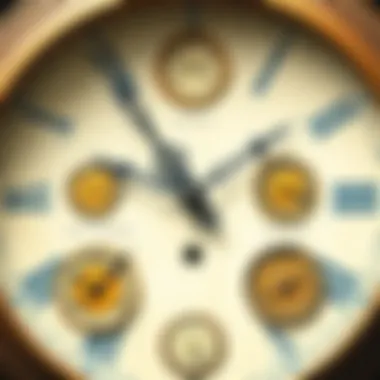
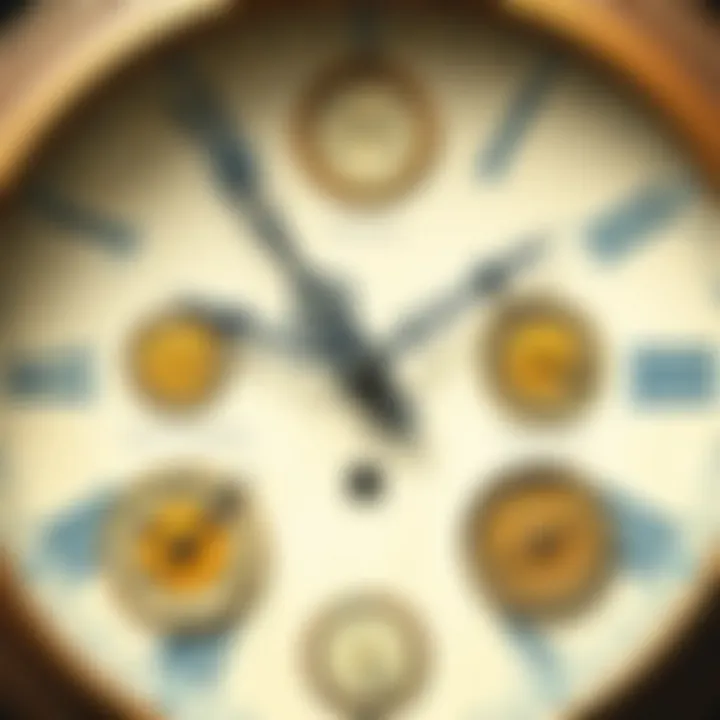
The Minute Hand
The minute hand is the longer and usually thinner hand in a clock. Its prime role is to indicate the minutes of the hour, thereby offering a more precise timekeeping experience. In many cases, it's moved every sixty seconds, completing its rotation in a full hour. Outfitted often with a more elegant design compared to the hour hand, the minute hand not just adds aesthetic value; it enhances functionality in a significant way.
People often rely heavily on this hand, especially when planning activities. For example, if you’re cooking a meal that requires attention down to the minute, watching this hand is crucial. Moreover, its clear demarcations allow users to plan their actions more meticulously.
The Second Hand
The second hand is often the most dynamic of the trio. With its quick tick-tock movement, it moves swiftly around the clock face, marking off each second with precision. This hand is pivotal in contexts where timing is critical—think racing cars or diving competitions. Unlike the hour and minute hands, the second hand may vary in design, with some clocks sporting a sweeping motion while others have a more segmented, ticking style.
One key feature of the second hand is its ability to indicate the rhythm of life itself, gathering seconds into minutes, representing the quick passage of time. Though often overlooked, it serves as a reminder that each second counts, making it an essential element of timekeeping.
Specialized Hands
Date Hands
Date hands take on the significant task of indicating the current day within the month. Often placed at the 3 o'clock or 6 o'clock position on the dial, these hands can show a numeral, sometimes enhanced through an aperture. It lets users keep track of dates without the need for a separate calendar. Given our busy lifestyles, knowing the date is crucial, whether for appointments or simply planning social events.
The unique feature of date hands is often how they can be manually adjusted or automatically updated in more advanced watches. These hands can be a bonus for individuals who juggle various responsibilities.
Moon Phase Hands
Moon phase hands depict the current phase of the moon, whether it be a new moon, a full moon, or somewhere in between. This feature integrates a poetic aspect into the mechanical world of timekeeping. People who appreciate the connection between time and nature often find these hands particularly enchanting, making them a popular choice for decorative and functional purposes.
The unique aspect of moon phase hands is the portrayal of lunar cycles, providing a natural rhythm to time. While they may not be absolutely necessary for everyday life, they serve as a beautiful reminder of the universe's patterns. However, they can come with the downside of added complexity to the watch's mechanism, making them a point of consideration for those seeking straightforward timekeeping.
The Mechanism Behind Clock Hands
Understanding the mechanism behind clock hands is essential for grasping how time is measured accurately and effectively. Without the right mechanisms, clock hands would not function, making the concept of timekeeping meaningless. The intricate workings of gears, springs, and power sources ensure that a clock's hands tell the right time, revealing their crucial roles in both practicality and design.
Gear Systems in Clocks
Gears are fundamental to the operation of mechanical clocks. They function like an orchestra, with every cog and wheel playing its part to create harmonious movement. Various types of gear systems contribute to the precise movement of clock hands, converting energy from their power source into the rotational motion that drives the hands around the dial.
Most clocks utilize a combination of transmission gears and gear trains to achieve accurate time display. The gear ratio influences how quickly the hour, minute, and second hands move. For instance, the minute hand moves at a different rate compared to the hour hand. The consistent meshing of gears ensures that each hand progresses according to its intended function.
Clockmakers often refine gear systems to achieve smoother motion, reduce friction, and extend the lifespan of the mechanisms. Understanding these systems is vital for appreciating timepieces as both functional instruments and items of art.
Power Sources
Clock hands require a reliable power source to maintain their movement. There are two dominant types used: mechanical movements and quartz technology, each with its own set of characteristics and advantages.
Mechanical Movements
Mechanical movements are the traditional heart of many clocks. These systems operate without electricity, relying on unwinding springs, gears, and weights to power the hands. The key characteristic of mechanical movements is their craftsmanship. They often embody an intricate artistry that appeals to horologists.
Many enthusiasts appreciate mechanical clocks for their vintage feel and intricate inner workings. However, they do require more maintenance and periodic winding, making them less convenient than quartz clocks. The beauty of mechanical movements lies in their exquisite engineering, as they derive energy from tension rather than batteries, giving them a unique charm.
Advantages of Mechanical Movements:
- Aesthetic craftsmanship and intricate design
- No reliance on batteries, making them environmentally friendly
- Often last for generations if maintained properly
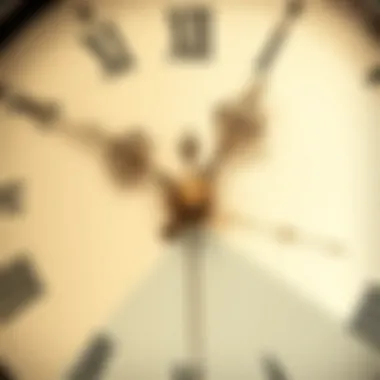
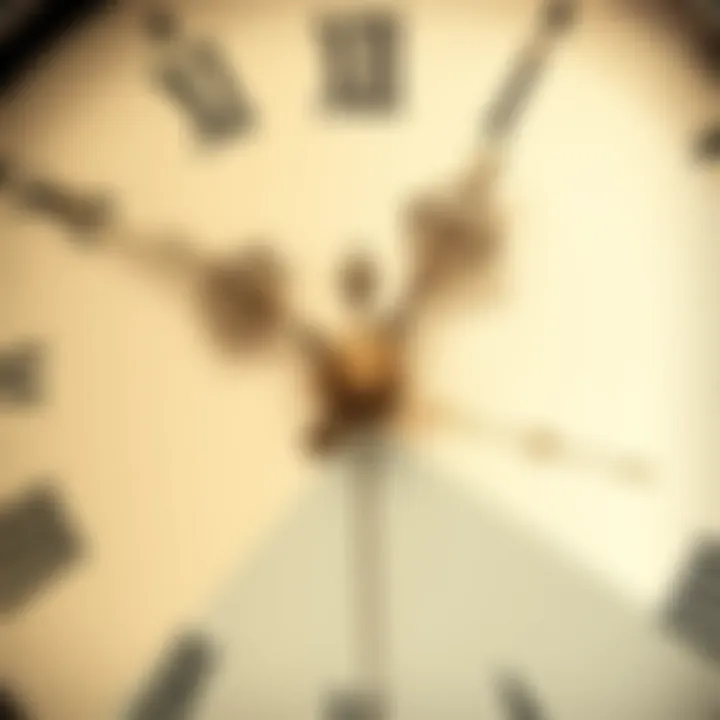
Disadvantages:
- Requires regular winding or maintenance
- More vulnerable to wear and tear due to moving parts
Quartz Technology
Quartz technology revolutionized timekeeping in the 20th century. It uses a quartz crystal oscillator to keep accurate time, providing a level of precision difficult to achieve mechanically. The key characteristic of quartz technology is its reliability; it rarely deviates from the true time, becoming a favored choice for both consumers and manufacturers.
The unique feature of quartz clocks is their battery-powered functionality, which allows for easy placement in various environments without the need for winding. This makes quartz clocks popular in homes and offices where convenience is essential.
Advantages of Quartz Technology:
- High precision and accuracy
- Low maintenance and easy operation
- Generally less expensive to produce and purchase
Disadvantages:
- Limited aesthetic appeal compared to intricate mechanical designs
- Powered by batteries, which can be a concern for environmentally-conscious consumers
As we progress through this article, it's essential to examine how historical development and aesthetic considerations further enrich our understanding of clock hands. For more reading on the fascinating topic of timekeeping, check out resources like Britannica and Wikipedia's Horology.
Historical Evolution of Clock Hands
The tale of clock hands journeys back to a time when mere shadows danced upon the ground, marking the passage of day and night. Understanding the historical evolution of clock hands is crucial for appreciating how timekeeping has morphed from rudimentary methods to intricate designs that we recognize today. This section sheds light on the milestones that paved the path for the clock hands we often take for granted. The narrative encompasses ancient devices, mechanical advancements, and modern innovations that together reveal a fascinating interplay between technology and art in horology.
Ancient Timekeeping Devices
Long before clocks ticked and tocked, people relied on the sun’s position to gauge time. Ancient civilizations devised various methods to keep track of time. One prime example is the sundial, which used the sun’s shadows to indicate the hour. These sundials were simple yet ingenious, often crafted from stone or wood, with a gnomon—a stick or a triangular blade—that cast shadows depending on the sun's movement. In areas with vibrant cultures, like Egypt and Greece, sundials were not merely functional; they were often adorned with exquisite carvings, blending artistry with practicality.
Moreover, water clocks, or clepsydra, emerged as another fascinating solution. These devices measured time through the regulated flow of water from one container to another. Just picture it: a gentle stream of water, subtle yet telling, marking minutes and hours, even in the absence of sunlight. Space didn't permit these ancient wonders to exhibit ornate hands, but their influence laid the groundwork for more complex designs that evolved in the future.
The Development of the Mechanical Clock
The advent of mechanical clocks in the Middle Ages marked a seismic shift in timekeeping capabilities. No longer reliant on celestial cues, these clocks utilized gears and weights to measure time with unprecedented accuracy. As craftsmanship progressed, so too did the articulation of hands that pointed to the hour and minute. The hour hand, now a mainstay in clock design, took the pivotal role of indicating the passage of a standard time frame, while the minute hand bridged the gap between vague estimations and precise time.
By the 13th century, mechanical clocks started appearing in European towns, often housed within church towers. This not only served the community but also showcased the ingenuity of the era's craftsmanship. The hands of these clocks began to sport decorative flourishes, reflecting both the aesthetic sensibilities and the technological advancements of the time.
Modern Innovations
Fast forward to the present, and clock hands are a blend of function and flair. Advances in technology have given rise to various materials such as aluminum and even low-density plastics. The designs can range from ultra-modern minimalistic lines to ornate styles reminiscent of earlier eras. Moreover, digital displays have introduced an alternative to traditional hands while still maintaining their nostalgic visuals in many gadgets and wristwatches.
The rise of smart clocks brought yet another evolution. Device interfaces feature hands moving around a screen, a nod to the classic design even while showcasing futuristic functionalities. As timepieces have transformed into smart devices, the fundamental need for clear and intuitive indicators remains unchanged.
"Every clock not only measures time but also tells a story. Understanding the evolution of its hands helps us appreciate the journey through time itself."
As we look to the future, the role of clock hands will likely evolve further, but the respect for history remains eternal. From ancient sundials to the sleek designs of smart clocks, the development of clock hands encapsulates a cultural timeline that reflects humanity's relationship with time.
This exploration of the historical evolution illustrates the ongoing dialogue between function and artistry within horology. Each tick marks an evolution; each hand signifies the metering of moments, eternally interwoven with our lives.
The Aesthetic Impact of Clock Hands
The aesthetic appeal of clock hands is something that often goes unnoticed in the daily hustle of modern life. Yet, these simple yet intricate components serve a profound role, where functionality dances with beauty. Clock hands help tell time, yes, but they also contribute to the overall look and feel of a timepiece. They can transform an ordinary clock into a work of art, capturing the eye and the imagination. Understanding this impact is vital, as it bridges the essential nature of horology with its artistic expression.
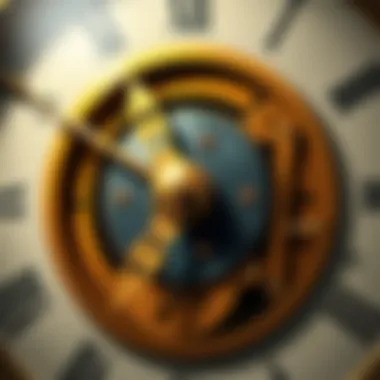
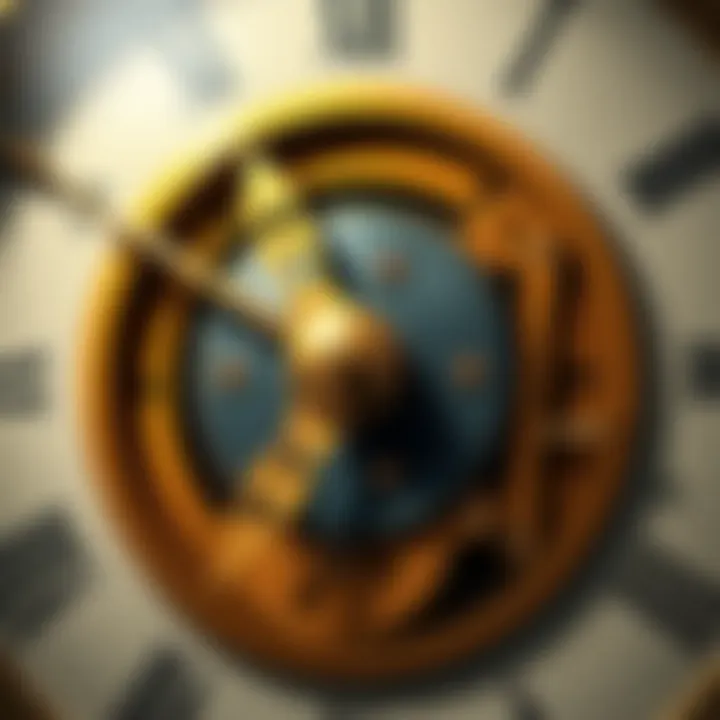
Design Styles Across History
The evolution of clock hand designs mirrors the artistic movements within society through various epochs. In the early days, clock hands were quite rudimentary, made from basic materials without much thought given to aesthetic appeal. They served one purpose – to point out the hours or minutes. Over time, however, different periods brought about significant changes.
- Renaissance Influence: During the Renaissance, the desire for beauty led to ornate designs. Clock hands became slender and elongated and often adorned with intricate engravings. These designs symbolized the rebirth of art and culture, showcasing mastery of craftsmanship.
- Art Nouveau: The late 19th to early 20th century saw the influence of Art Nouveau, where clock hands took on floral and organic shapes. This fluidity expressed the natural world and was a departure from the rigid forms of earlier designs.
- Modern Minimalism: Fast forward to the 20th century, and minimalism emerged. Here, clock hands were stripped down, focusing on form, balance, and function. Clean lines and simple designs define this era, making it a favorite for contemporary decorators.
Each of these styles not only tells us about the time but also whispers the story of the people and culture that crafted them. The design of clock hands provides a glimpse into historical values and artistic endeavors.
Cultural Variations in Clock Hand Design
Clock hands are much more than functional; they embody cultural stories and beliefs that vary significantly from one region to another. It's fascinating how these small elements carry a rich tapestry of meanings and aesthetics.
- Asian Designs: In many East Asian cultures, clock hands can symbolize balance and harmony. Simple yet elegant designs often reflect philosophical beliefs, encapsulating ideas such as Yin and Yang, which promotes symmetry and equilibrium.
- European Variations: In Europe, particularly during the Baroque period, clock hands often portrayed grandeur. Designs were lavish with embellishments, where gold plating was not uncommon, reflecting the opulence of the time.
- Indigenous Aesthetics: Indigenous communities may incorporate spiritual symbols into clock hand designs. These are often hand-carved and deeply personal, representing not just the passage of time but also narratives from cultural traditions.
Clock hands tell stories that expand beyond their primary function, reflecting regional identities, artistic expressions, and belief systems around the globe.
"Clock hands are not mere indicators of time but storytellers steeped in history, artistry, and culture."
Clock Hands in Artistic Expression
Clock hands are not just functional elements; they hold a rich tapestry of meanings and interpretations in various forms of artistic expression. When one gazes at a clock, it's easy to just see the hands moving around their circular path. However, these clock hands often represent deeper ideas, sentiments, and cultural artifacts. The importance of this topic lies in recognizing how elements of horology weave themselves into the fabric of society's creativity and thought processes.
At first glance, the design of clock hands might seem to play a secondary role compared to the body of the clock itself. But when we take a closer look, we realize their intricate designs and movements resonate with beauty, symbolism, and craftsmanship. For example, a delicate leaf-shaped minute hand can evoke nature's cycles, while a bold, angular hour hand might draw on themes of precision and modernity. They embody not only timekeeping but also the artistic values of the era they stem from. Different cultures have mirrored their philosophies and artistic inclinations through the hands of their clocks.
As the art world evolved, so did the interpretations of these clock hands. Artists and designers have often used them as symbols of various themes:
- Impermanence: The steady movement of clock hands reminds us that time is not only a measure of moments but also a carrier of memories.
- Change: The movement from one hour to the next embodies transformation and the fluid nature of life.
- Unity: The convergence of hands at twelve symbolizes togetherness, often celebrated in artwork, in the form of family gatherings or significant milestones in life.
"Every tick and tock whispers the stories of lives lived and the moments that shape our existence."
Clock Hands as Symbols
Within the realm of symbolism, clock hands take center stage in various cultural narratives. The function of displaying time metamorphoses into a metaphor for life and the human experience. For instance, in many artistic traditions, the hands signify the unyielding march of time. In literature, characters grappling with their existence often reference clocks as they struggle with their choices and destinies.
Moreover, the specific designs of clock hands can vary significantly. Ornate, embellished hands found in vintage clocks might symbolize nostalgia or the elegance of a bygone era. On the contrary, minimalist designs echo a sense of modernity, emphasizing simplicity in a world saturated with choices.
Incorporation in Art and Literature
Clock hands also find a significant place in both art and literature, offering insights into the human condition. Artists have long drawn inspiration from the rhythm of time punctuated by these simple yet profound elements. In paintings and sculptures, clock hands serve to remind viewers of the relentless progression of time. Notably, Salvador Dalí’s melting clocks in The Persistence of Memory manifest how time can bend and warp, echoing the surreal interplay of reality and dream.
In literature, authors employ the metaphor of clock hands to delve into complex themes of mortality and longing. Many pieces illustrate how characters are bound by the constraints of time, using clocks as a focal point to convey emotion and urgency. For example, in the Great Gatsby, the slow ticking of the clock serves as a backdrop to the characters' yearning for lost time and fractured relationships.
Closure
Bringing this exploration of clock hands to a close, it’s essential to reflect on their multifaceted significance in both timekeeping and design. Far from being simple indicators of time, clock hands delve into the realms of culture, art, and functionality. They unite practical utility with beauty, making them pivotal components of horology.
The Future of Clock Hands
As we look ahead, the future of clock hands seems promising yet intriguing. Advancements in technology are continually shaping how we perceive time. While traditional analog clocks still hold a special place in our hearts, the rise of digital displays and smart technology introduces new dimensions for how we keep and understand time. Yet, even in a digital age, the charm of mechanical movement and the elegance of finely crafted clock hands are unlikely to fade completely.
Developers are finding ways to fuse classic designs with modern tech—think smartwatches that keep the distinctive feel of traditional watch hands. This blend ensures that while we step into a future dominated by fast-paced advancements, we still appreciate the significance of these timekeepers. Whether it's through sustainable materials or innovative designs, the story of clock hands will continue to evolve and resonate with future generations.
Final Thoughts
In sum, clock hands embody more than just practical tools for conveying time; they narrate the tale of human innovation and creativity. From the early sundials to intricate mechanical masterpieces and contemporary digital representations, each advancement illustrates a commitment to both functionality and artistry. Clock hands remain symbols of our collective journey with time, prompting us to reflect on how we measure not only hours, but life itself.
Our clocks challenge us to ponder: How do we wish to represent our own experiences within the confines of time? By valuing the craftsmanship and thought behind each clock hand, we gain a deeper appreciation for the interplay between hours and artistry in our everyday lives.







